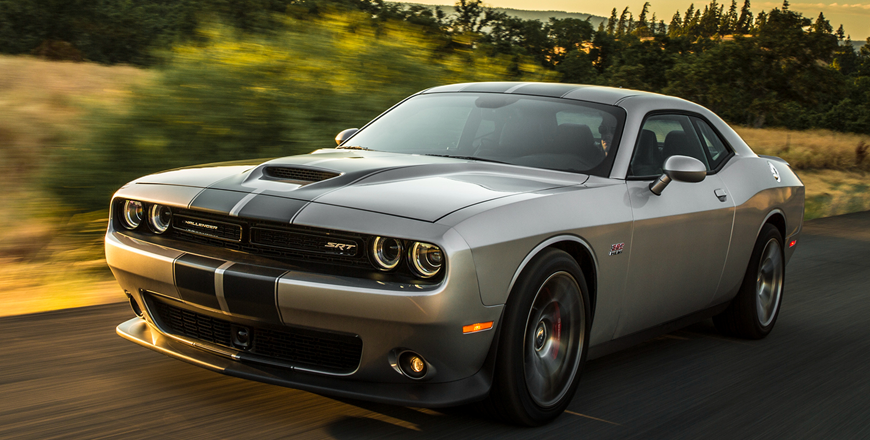You are here
Hell on wheels
By Ghaith Madadha - Jun 29,2015 - Last updated at Jun 29,2015

Photo courtesy of Dodge
The world’s most powerful regular production saloon, the Dodge Charger SRT Hellcat — and its 2-door Challenger sister — is also the most powerful factory-built muscle car. With a supercharged 6.2-litre V8 developing 707BHP, the Hellcat not only eclipses the standard 485BHP Charger SRT, but in terms of brute power, out-performs Dodge’s own 640BHP Viper supercar.
Large, luxurious and thoroughly well-kitted yet wearing an honest and unpretentious badge, the Hellcat’s power, design and name unapologetically celebrate its raw power and muscle car heritage. And a big part of the Hellcat’s appeal is its ability to out-muscle virtually any pricier and snobbier luxury saloon short of heavily modified and exorbitantly priced aftermarket tuner offerings.
Dramatic demeanour
Arriving as the range-topping version of the revised 2015 Charger model line, the Hellcat features a more muscular take on the same face-lifted body. With new slim grille and rounded LED headlights and heavily browed face, the Charger’s already assertive, athletic and more urgently dynamic revised design is well complemented by the Hellcat version’s more dramatic treatment.
Sitting lower and massive trapezoidal lower intake and blacked out bumper segment, sharper front apron, rear diffuser, bootlid spoiler and hood scoop, the hot Charger SRT is already an aggressive and moodily dramatic take of the base car’s sculpted design. In addition to badges, little but additional and practical airflow styling changes differentiate the Hellcat.
Sitting below its bulging prominently scooped bonnet, the Hellcat’s intensely powerful and robust cast-iron block and aluminium head 6.2-litre supercharged V8 engine and immense hardworking ventilated perforated 390mm front and 3500mm rear disc brakes require more effective airflow solutions, And so, the Hellcat features additional side air ducts in place of foglights and bonnet extractor vents.
Devastating Dodge
A heavily reworked version of the Dodge’s faithful Hemi V8 engine, the supercharged Hellcat version uses 90 per cent new parts for reduced friction and enhanced cooling and robustness to withstand the stress and heat of its prodigious output. Developing 707HP at 6000rpm and gut-wrenching 650lb/ft
torque at 4800rpm, the Hellcat engine is the Chrysler group’s most powerful ever.
Devastatingly effective, with visceral deep bassy rumbles and intake gurgles the Hellcat’s soundtrack hardens to a thunderous bellow underlayed by distinctive supercharger whine at heavy load high revs. Capable of 328km/h and an 11-second standing quarter mile, the Hellcat’s acceleration has variably been quoted between 0-97km/h in 2.9-second and 0-100km/h
in 3.7 seconds using the launch control function.
Brutally volcanic at top-end, the Hellcat is however muscular and versatile throughout its rev spectrum. Ready to pounce from tick-over, torque and power accumulate with intense linearity at full load. With effortlessly accessible and vast reserves, it is understood that unhindered, the Hellcat would produce 830BHP without mechanical modification, but is electronically de-tuned for emissions and drivability purposes.
Composed and quick
Driven through a smooth and swift shifting 8-speed automatic gearbox, the Hellcat features three selectable gear shift modes with escalating aggressiveness, and can hold gears and can be manually shifted through steering-mounted paddle shifters. Meanwhile, a limited-slip rear differential varies power allocation to the driven rear wheels to crucially maintain road holding and improve agility through corners.
Surprisingly refined, accessible and with throttle control well-measured for precision and drivability, the Hellcat is composed and confident, but shouldn’t lull one into mistaking this for docility. Sensationally swift, the Hellcat’s brutal engine can break its admittedly strong-gripping 275/40R20 tyres’ traction if one carelessly comes back on power too early or too hard in corners.
More agile car than its 2075kg weight suggests, the Hellcat is more buttoned down composed and responsiveness than non-SRT Chargers. With quick direct 2.52-turn hydraulic-assisted steering and sports-tuned front double wishbone and rear multi-link suspension, it turns in tidily. Meanwhile taut Bilstein adaptive damping well-controls body roll through successive corners, while electronic brakeforce distribution ensures composed level braking.
Refined brute
Driven on Abu Dhabi’s Yas Marina Formula One Circuit the Hellcat was stabile, pinned down and refined at speeds far north of 200km/h, while body control and lateral grip and body roll were reassuringly composed through sweeping fast off-camber corners. Smoothly firm riding, the Hellcat cabin was well insulated, while vertical control seemed well composed.
Spacious and comfortable inside, the driven Hellcat featured grippy, supportive and well-adjustable two-tone Alcantara seats, and with tilt and reach contoured sports steering adjustability, one could find a good driving position easily, even wearing a helmet. Spacious inside, the Hellcat also boast particularly good rear seat width and legroom, and features a spacious 467-litre boot.
Tastefully designed with driver-tilted console, the Hellcat is also well equipped with driver assist, convenience, safety and infotainment kit. Along with user-friendly controls and instruments including a 7-inch instrument display screen and intuitive 8.4-inch Uconnect infotainment system, from where driving modes are accessed, the Hellcat also features useful parking assistance and an extensive list of standard and option features.
TECHNICAL SPECIFICATIONS
Engine: 6.2-litre, supercharged in-line V10 cylinders Bore x Stroke: 103.9 x 90.9mm Compression ratio: 9.5:1 Valve-train: 16-valve, OHV, variable valve timing Gearbox: 8-speed automatic, rear-wheel-drive, limited-slip differential Gear ratios: 1st 4.71 2nd 3.14 3rd 2.10 4th 1.67 5th 1.29 6th 1.0 7th 0.84 8th 0.67 Reverse/final drive ratios: 3.3/2.62 Power, BHP (PS) [kW]: 707 (717) [527] @6000rpm Specific power: 114.7BHP/litre Power-to-weight: 340.7BHP/tonne Torque lb/ft (Nm): 650 (881) @4800rpm Specific torque: 142.88Nm/litre Torque-to-weight: 424.5Nm/ton Rev limit: 6200rpm 0-100km/h: under 3.5 seconds 0-400-metres: 11 seconds Top speed: 328km/h Fuel consumption, city/highway/combined: 18.09/10.69/14.7/100km* *US EPA Fuel capacity: 70 litres Fuel requirement: 95RON Wheelbase: 3058mm Track, F/R: 1625/1618mm Kerb weight: 2075kg Weight distribution, F/R: 56 per cent/44 per cent Aerodynamic drag co-efficiency: 0.335 Cargo volume: 467 litres Steering: Hydraulic rack & pinion Turning circle: 11.7 metres Lock-to-lock: 2.52 turns Suspension F/R: Unequal double wishbones/multi-link Brakes, F/R: Ventilated perforated discs 390 x 34mm/350 x 28mm Brake calipers, F/R: 6-/4 pistons Tyres: 275/40ZR20 |
Related Articles
Part of a heavily revised Dodge Charger line-up introduced for 2015, the SRT 392 receives a slight power hike and new gearbox to go with its
Introduced in 2015 as part of a revised Dodge Challenger coupe line-up, the SRT 392 is an evolution of the model line’s previous high perfor
Among the most evocative and honest of all car segments with its emphasis on undiluted thrills, aggressive designs, feelgood flavours and vi


















